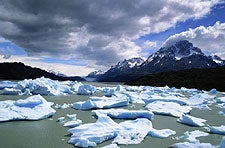 Bergelicious: ice soup off Chile’s Patagonian coast
Bergelicious: ice soup off Chile’s Patagonian coast Q: Where are the best places to sea kayak in Chilean Patagonia? Also, do you know of any outfitters in Punta Arenas that provide good equipment without international prices? Thanks,
— Patrick, Lima, Peru
���ϳԹ��� Advisor:
A: Language lesson for the day: “babear” is Spanish for “to drool,” which is what tends to happen to seasoned kayakers when they catch their first glimpse of the Patagonian coast. At the edges of narrow channels, monstrous chunks of ice undercut lush valleys, thick clouds cover the tips of distant peaks, and waterfalls spill over frozen cliffs into the sea. There’s a reason this destination has become a pilgrimage among sea kayakers. Few landscapes in the world can compare.
Of course, with so many options to choose from, picking the best jumping-off point is no easy matter. Still, almost any short list of candidates would include Puerto Natales, an easy place to hop into fjord country with the help of local outfitters; the Chiloé Archipelago, where you can paddle from island to island in the Ancúd Gulf; and Pumalín Park, a reserve owned by gringo clothing-magnate-turned-conservationist Doug Tompkins. Tompkins has said his goal in purchasing more than half a million acres of land in the early 1990s was to turn it into a sort of Chilean Yosemite, without the hefty entry fees and hokey concessionaires. You’ll hear few arguments to the contrary among paddlers who have sampled his 53-mile coastline.
So far as outfitters go, bargain hunters can expect two problems: First, sea kayaking is an industry supported by foreigners, so there’s really no getting around the “international” pricing. You can usually cut costs a little, however, if you make your plans directly through the outfitter instead of booking through an overseas-based agency. Second, if you were hoping to save cash by renting gear and exploring on your own, good luck. In Chile, outfitters are legally liable for whatever happens to kayakers who rent their gear, so you’re going to have a hard time finding someone willing to set you loose without a guide.
These locally-run outfitters are a good place to start: Onas Patagonia () runs trips out of Puerto Natales, and Altué Active Travel () operates out of Dalcahue, on Chiloé Island. Both offer reasonably priced, camping/kayaking trips led by experienced guides. In Punta Arenas, try Ecotour Patagonia (). Their $80, eight-hour day of guided paddling in the Strait of Magellan is one of the best deals around.
Bottom line: the best place to kayak is wherever you end up. In Patagonia, you really can’t go wrong.


